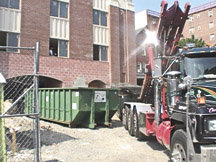As luxury high rise development continues to sprout along Jersey City’s “Gold Coast,” there’s a perhaps less noticeable building boom taking place elsewhere in the city.
The Jersey City Redevelopment Agency and the Franklin Redevelopment Group are just months away from groundbreaking on the Mary O’Malley Homes, 16 units of workforce housing in the Jersey City Heights that will ultimately be sold to moderate income families. The O’Malley development, on North Street overlooking Washington Park, will be the fourth workforce housing complex to be built by the Jersey City Redevelopment Agency with funding from the New Jersey Mortgage and Finance Agency’s CHOICE Program.
‘Thousands of housing units have been created in the city, perhaps none more important than the eight we built at Harriet Tubman.’ – Robert Antonicello
____________
While some communities have been reticent to build affordable and workforce housing, the Jersey City Redevelopment Agency and its executive director, Robert Antonicello, have come to see it as a lynchpin of the city’s economic rebirth.
“When I came to this agency five years ago, I wanted us to look at renewal opportunities in the city,” said Antonicello. “The key to it is the fact that you’ve got people making between 80 and 120 percent of the area median income. So, you have people with money in their pocket. They have disposable income. So, when they walk out of their units, they can actually patronize a store beyond just [buying] basic necessities. Through that, I knew we could begin to put these neighborhoods back together again.”
Keeping modest wage earners in Jersey City, Antonicello added, is what will attract new businesses and shops to such areas of the city as Journal Square, the Jersey City Heights, the Martin Luther King Jr. corridor, and other communities that are struggling economically.
“Thousands of housing units have been created in the city, perhaps none more important than the eight [townhouses] we built at Harriet Tubman,” Antonicello said. “They’re more important than the luxury [housing] we build on the waterfront.”
Home ownership, made affordable
As Jersey City has become a trendy destination for tony professionals from across the Hudson, there has been some concern that rising housing prices – pushed up in part thanks to the waterfront housing boom – might push out residents who are teachers, firefighters, police officers, civil employees, and others who provide essential city services.
According to Jersey City Redevelopment Agency, the median income in Jersey City in 2008 was $43,426, an income that would only qualify for a home mortgage of $217,000. Yet, the average Jersey City home that year cost $359,100. Home ownership in Jersey City was in danger of becoming unattainable for many – perhaps even most – of the city’s residents.
The Jersey City Redevelopment Agency started its Workforce Housing Plan in 2006 to create home ownership opportunities for moderate-income residents.
Through the program, families who earn at least $60,000 who can qualify for a mortgage are able to purchase the workforce homes for sale prices in the mid-$200,000 range, according to a city spokeswoman. Qualified residents are able to buy with as little as a three or five percent down payment.
“Jersey City is one of the few Hudson County [cities] that’s doing anything meaningful on affordable housing,” said John Restrepo, director of housing and community development for the Jersey City Episcopal Community Development Corp. “There are very low vacancy rates in Hudson County because there’s such a high demand for housing. How many folks who were here prior to the waterfront explosion are being pushed out as a result of housing prices being driven up? The displacement of folks in the community is a problem because rarely do we see proactive public policies that create affordable housing opportunities for these people who are in danger of being pushed out of their community.”
The Jersey City Episcopal Community Development Corp. has partnered with the city to create a few affordable housing units.
Restrepo’s only complaint about the city’s Workforce Housing Plan is that it currently does not include any rental property.
Antonicello agrees this is a problem. He explained that since funding for the program comes from the New Jersey Mortgage and Finance Agency’s CHOICE initiative it is required to be a program that promotes home ownership. He said his agency is looking at ways to create affordable workforce housing for the rental market.
Affordable, and green
The units being built as part of the workforce housing program are also LEED (Leadership in Energy and Environmental Design) certified projects that were constructed to keep energy and water costs low and reduce the level of carbon emissions.
The Margaret S. Herbermann Manor, one of the city’s workforce housing developments, has a silver LEED certification, for example.
“When we started talking about this housing, we started off talking about sustainable housing, durable housing,” Antonicello stated. “People looked at us like we were crazy, they didn’t understand it.”
He said that any affordable housing units built without such standards in mind these days are “a cruel joke,” because residents are forced to spend their meager financial resources on outdated and expensive utility costs.
Keeping energy and utility costs low, again, frees up disposable income that Antonicello said residents can use to support their families and the local economy.
“When we lose the cop, the fireman, the school teacher, the retail manager, when we loet these people in these neighborhoods, we lose more than just neighbors. We lose the guy who’s coaching the Little League team. We lose the mom who was running a Girl Scout troop,” Antonicello insisted. “If we want to renew our communities, we must keep these residents in the city. And workforce housing is really the key to doing that.”
E-mail E. Assata Wright at awright@hudsonreporter.com.
